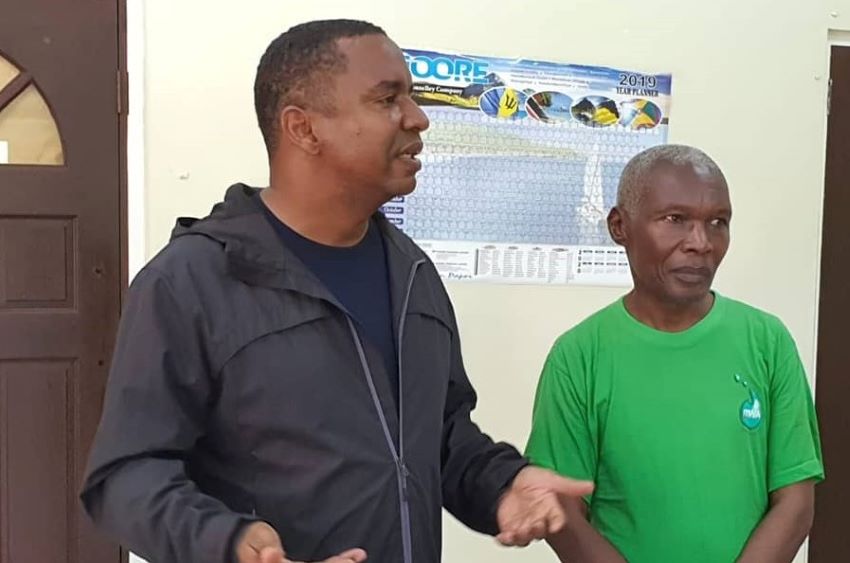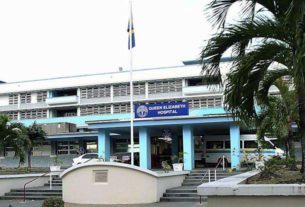Minister of Energy and Water Resources, Wilfred Abrahams speaking to the media before heading on a tour of the cave at the Bowmanston Pumping Station in St. John. Looking on are BWA’s Technical Advisor to the Board, Dr. John Mwansa ( left) and CBC journalist, Shane Sealy. (S.Forde-Craigg/BGIS)
Minister of Energy and Water Resources, Wilfred Abrahams, believes it was necessary to tour the cave, located at the Barbados Water Authority’s (BWA) Bowmanston Pumping Station in St. John, to gain a better understanding of the challenges being experienced there.
“I like to understand what it is I am talking about … because I can best explain it to the public, or to my fellow ministers if I understand, and the other thing was, I keep passing information to the press second-hand, so I get it from Dr. Mwansa, I then pass it to you.
“It was also critical for the press to understand, because realistically, for this message to get home to Barbadians I can say it, but I need you to carry it. You may write the story based on what I say, but I’m sure that those who went down the whole way through, it is one thing to hear it, it’s a next time to see it,” Minister Abrahams said.
Now having being on the tour, the Minister responsible for the BWA, hopes that the media could convey the deficit of water being experienced at the cave, and also the process that occurs between capturing water when the rain falls and how that water eventually makes it to our taps.
Minister Abrahams emphasized that this would assist in answering why the water levels are low or the taps dry, if the rain recently fell.
“People need to understand something; there are a number of factors at play, as Dr. Mwansa indicated. It normally takes 90 days for the water that hits the surface of the earth to get through into our aquifer.
“Sometimes, if there is excessive rainfall and flooding it might find fissures of direct connection into the aquifer, but a normal filtration scheme of things takes 90 days. So, when you see the rain falling the impact of that rain is generally not going to be felt for about a couple of months.”
He also highlighted that one of the largest consumers of the island’s water supply is the agriculture sector, and when the rain falls, farmers don’t have to irrigate their crops.
But during the dry season and the current drought situation, farmers have to utilise water from the island’s distribution system to irrigate their crops, and that impacts the amount available for domestic consumption.
Stressing that climate change has played a major role in the reduction of rain fall and drought situations across the globe, Minister Abrahams encouraged the media to carry the message about the disparity of water levels the authority is experiencing at its pumping facilities, and to promote ways the public can conserve the way they use water.
“Water is like the new oil, so we need to stop wasting water; we need to follow the water authority’s tips,” Minister Abrahams added, which could assist in conserving water, so residents in elevated parishes can have a better supply of water.
To address the issues facing the BWA over the next two to three years, the BWA will seek to supplement the supply of water with projects that include the Vineyard project; construction of new reservoirs and booster stations; replacement of mains; the installation of two temporary package desalination plants and the supply of industrial desalination water.
BY SHEENA FORDE-CRAIGG | JUL 2, 2020
sheena.forde-craigg@barbados.gov.bb
Water Levels At Bowmanston Extremely Concerning

Minister of Energy and Water Resources, Wilfred Abrahams and Barbados Water Authority’s (BWA) Technical Advisor to the Board, Dr. John Mwansa explain some of the water challenges being faced at the Bowmanston Pumping Station. (S.Forde-Craigg/BGIS)
Barbados Water Authority’s (BWA) Technical Advisor to the Board, Dr. John Mwansa, describes the water levels at the Bowmanston well as “extremely concerning”.
During a tour on Wednesday of the cave, located beneath Bowmanston Pumping Station, Minister of Energy and Water Resources, Wilfred Abrahams, staff of the Ministry and BWA, as well as media personnel, received a first-hand visual experience of the current water deficit in the cave.
The Technical Advisor, explaining why he was extremely concerned about the deficit of the water level in the cave, said: “The last time we went into the well to check was in November 2019. When we did that, when we stepped on to the well the water level was so high, immediately we had to start swimming to go to the Check Dam.
“Today, when we stepped out of the well, we had to step down the ladder 15 feet to the bottom of the well and that was dry, so when you look at the depth of water that is in the cave, there’s a difference of about 15 to 20 feet between what it was in November last year and what it is now.”
Dr. Mwansa also informed the media that because the water level was so low downstream, it impacted the level upstream, where the pumping station pumps are connected to the cave. As a result, the capacity for pumping at the Bowmanston Pumping Station is reduced.
He said this reduction in pumping not only affects the distribution of water to residents of St. John and parts of St. George, but it also impacts the reservoirs at Golden Ridge and Castle Grant, which service residents of St. Joseph and St. Thomas.
He further explained that “because you have reduced the amount of water that you are bringing in from the well … the reservoir level will drop …, so if you continue pumping you will damage the pumps as well,” because they will start to “suck in air”.
Dr. Mwansa stressed therefore that the BWA has no choice but to turn off the pumping system to allow the reservoir to replenish.
As a result, residents in the above-mentioned parishes, receive either an intermittent supply of water, or experience low water levels, and have to be serviced with water tankers during the time the station is offline.
The Technical Advisor highlighted that “on average we pump about 1.5 to 2 million gallons [of water] a day from the Bowmanston Cave to feed into the [distribution] system”.
With the current levels being so low, he stressed that without heavy rainfall during the rainy season, which is usually June to November, the situation at Bowmanston and other pumping stations across the island would continue to experience low water levels and in turn the distribution of water to residents and businesses will be impacted.




